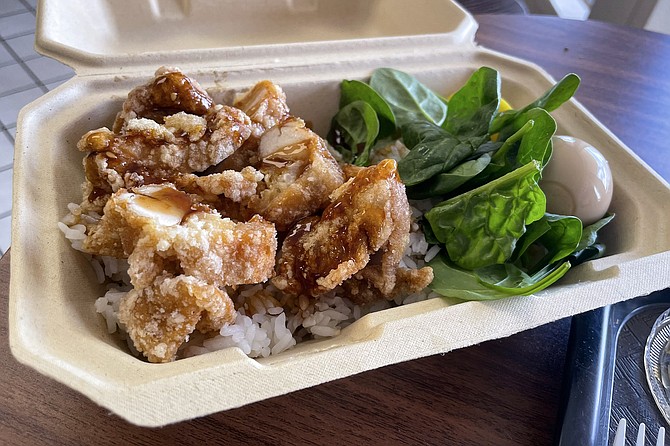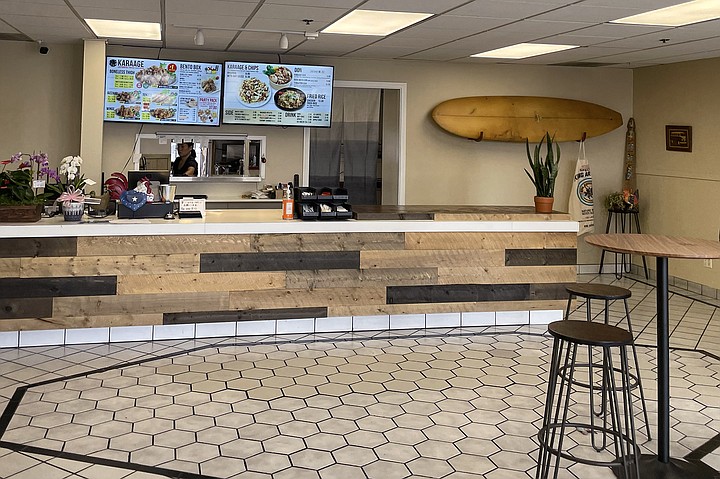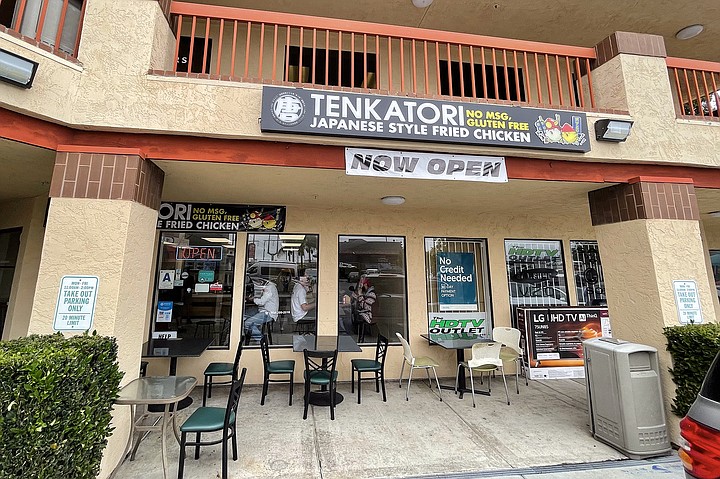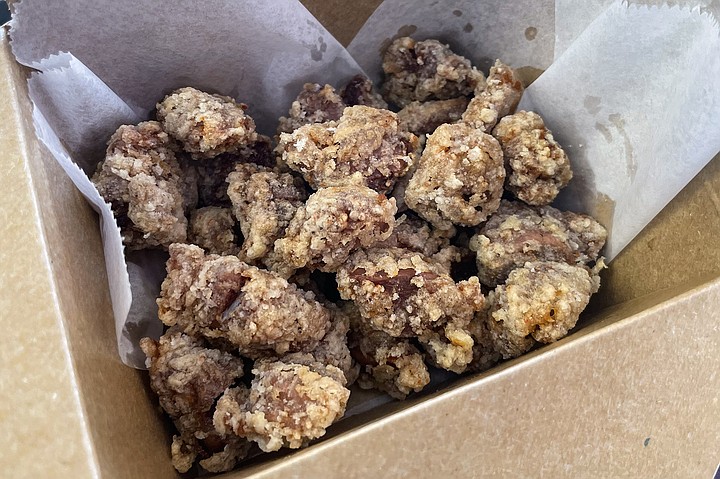 Facebook
Facebook
 X
X
 Instagram
Instagram
 TikTok
TikTok
 Youtube
Youtube

Slowly but surely, a Japanese fried chicken outfit called Tenkatori Karaage has been making its way across Southern California. Since 2016, its opened a couple locations in greater Los Angeles and one in Orange County, and finally launched in San Diego this spring. With each opening, the brand has vaguely touted a nearly 70-year-old karaage backstory, giving the impression it’s a big deal back home. Not that most of us here in the U.S. would know any better.
My initial reading is that it must be a competitor to Karayama, a karaage chain with dozens of locations across Japan, or Tenka Torimasu, another that garnered headlines a few years ago for marketing fried chicken claiming to taste like “girl sweat”. But Tenkatori hasn’t anything near the notoriety of these brands. However, with a lot of help from Google translate, I’ve sussed out the place Tenkatori does have in karaage lore.

Apparently, Japan’s Oita prefecture has two major claims to fame: onsen baths and fried chicken. While hot spring fed onsen bathhouses are popular all over Japan, Oita boasts the highest concentration, thanks to a reputed 4,788 volcanic hot springs. And though karaage fried chicken shops may also be found across Japan, this specific fried chicken trend is said to have started in the Oita city of Usa, way back in 1955.
That dates it nearly as far back as Kentucky Fried Chicken, and the respective origin stories start out similarly. In Kentucky, Colonel Sanders enjoyed success selling affordable fried chicken meals out of his depression-era roadhouse restaurant, and eventually spun its popularity into the franchise we now know as KFC. Meanwhile, in postwar Usa, Masao Fukuda started selling his own spin on fried chicken out of his lunch restaurant, Kuraiken.

Except, rather than grow into an entire planet filled with Oita Fried Chicken franchises, Fukuda’s karaage went a different route. According to the Japanese site for Tenkatori, Fukuda shared his fried chicken technique with the proprietor of a neighboring izakaya, who introduced karaage to a dinner crowd. That restaurateur went on to open the first take-out shop dedicated to karaage. Its success spawned a host of imitators, and led to a wave of karaage specialty shops throughout Usa, Oita, and beyond.
Back to the current day, the Tenkatori franchise has grown out of Oita courtesy of Fukuda’s son, spun off his own restaurant, Rairaiken. Over the past decade, it appears to have grown to a handful of locations in Japan — about as many as there are now in the U.S.

Which is a very long way to go about saying: don’t expect Tenkatori to have quite the same level of resources we’re accustomed to seeing from American franchise expansions. Though the seminal chicken recipe may in fact date back 70 years, it doesn’t necessarily have seven decades of growth behind it. Which is likely a factor to the choice of location for the first Tenkatori franchise in San Diego: not on Convoy, not downtown, but in an industrial corner of Miramar.
And not in a highly visible location either. Despite a Miramar Rd. address, Tenkatori opened within an obscure shopping center accessed via the connecting road, Commerce Avenue. How obscure? I’ve been to thousands of local restaurants working on this column, yet somehow never set foot here.
But I love Japanese food, and love fried chicken, so there was never any doubt I would seek out a 70 year old fried chicken recipe. As with most karaage establishments, the marinade behind the chicken’s distinct flavors are kept secret. However, we do know that it’s battered with potato starch (making it gluten free), features no MSG, and gets fried to-order, in oil refreshed at least once per day.
Being fried to-order means it’s delightfully crispy, but not exactly a fast food. I’ve read accounts of orders taking 10-15 minutes, and I can attest that a busy lunch rush pushes that out to 20 minutes. To their credit, the folks behind the counter will let you know how long to expect before ringing up your order.
For San Diegans eager to taste the historically relevant chicken recipe, the easiest and safest bet is to order the fried chicken thighs, breasts (tenders), or wings. Any of these run 7 to 20 bucks, depending how much you order, you can’t go wrong, particularly if you add a house-made dipping sauce. At a buck each, these include sweet and sour, sweet and spicy, tartar sauce, or the surprisingly satisfying yuzu aioli.
If you’re looking for a slightly more well-rounded meal, you can take your choice of chicken parts with rice and cabbage in a bento box ($10-11), served over French fries ($9-10), or as a sort of bowl (don) with rice, spinach, hard-boiled egg, and pickled daikon radish.
Let’s say that a side of uncooked, undressed baby spinach serves as reminder this is not your typical, American fried chicken franchise. However, if you’re really curious to see how karaage specialty shops operate, you can go with chicken parts you won’t find — by name at least — at a KFC: fried cartilage or chicken gizzards. Each offer a decidedly chewier texture than muscle meat, and the low-fat gizzards offer an element of offal flavor. I found it reasonably good, though once I felt full enough, I didn’t weep to leave half my 7-ounce order uneaten.
Tenkatori is definitely one for hard core karaage enthusiasts to seek out. The rest of us may need to tire of Nashville hot chicken first.


Slowly but surely, a Japanese fried chicken outfit called Tenkatori Karaage has been making its way across Southern California. Since 2016, its opened a couple locations in greater Los Angeles and one in Orange County, and finally launched in San Diego this spring. With each opening, the brand has vaguely touted a nearly 70-year-old karaage backstory, giving the impression it’s a big deal back home. Not that most of us here in the U.S. would know any better.
My initial reading is that it must be a competitor to Karayama, a karaage chain with dozens of locations across Japan, or Tenka Torimasu, another that garnered headlines a few years ago for marketing fried chicken claiming to taste like “girl sweat”. But Tenkatori hasn’t anything near the notoriety of these brands. However, with a lot of help from Google translate, I’ve sussed out the place Tenkatori does have in karaage lore.

Apparently, Japan’s Oita prefecture has two major claims to fame: onsen baths and fried chicken. While hot spring fed onsen bathhouses are popular all over Japan, Oita boasts the highest concentration, thanks to a reputed 4,788 volcanic hot springs. And though karaage fried chicken shops may also be found across Japan, this specific fried chicken trend is said to have started in the Oita city of Usa, way back in 1955.
That dates it nearly as far back as Kentucky Fried Chicken, and the respective origin stories start out similarly. In Kentucky, Colonel Sanders enjoyed success selling affordable fried chicken meals out of his depression-era roadhouse restaurant, and eventually spun its popularity into the franchise we now know as KFC. Meanwhile, in postwar Usa, Masao Fukuda started selling his own spin on fried chicken out of his lunch restaurant, Kuraiken.

Except, rather than grow into an entire planet filled with Oita Fried Chicken franchises, Fukuda’s karaage went a different route. According to the Japanese site for Tenkatori, Fukuda shared his fried chicken technique with the proprietor of a neighboring izakaya, who introduced karaage to a dinner crowd. That restaurateur went on to open the first take-out shop dedicated to karaage. Its success spawned a host of imitators, and led to a wave of karaage specialty shops throughout Usa, Oita, and beyond.
Back to the current day, the Tenkatori franchise has grown out of Oita courtesy of Fukuda’s son, spun off his own restaurant, Rairaiken. Over the past decade, it appears to have grown to a handful of locations in Japan — about as many as there are now in the U.S.

Which is a very long way to go about saying: don’t expect Tenkatori to have quite the same level of resources we’re accustomed to seeing from American franchise expansions. Though the seminal chicken recipe may in fact date back 70 years, it doesn’t necessarily have seven decades of growth behind it. Which is likely a factor to the choice of location for the first Tenkatori franchise in San Diego: not on Convoy, not downtown, but in an industrial corner of Miramar.
And not in a highly visible location either. Despite a Miramar Rd. address, Tenkatori opened within an obscure shopping center accessed via the connecting road, Commerce Avenue. How obscure? I’ve been to thousands of local restaurants working on this column, yet somehow never set foot here.
But I love Japanese food, and love fried chicken, so there was never any doubt I would seek out a 70 year old fried chicken recipe. As with most karaage establishments, the marinade behind the chicken’s distinct flavors are kept secret. However, we do know that it’s battered with potato starch (making it gluten free), features no MSG, and gets fried to-order, in oil refreshed at least once per day.
Being fried to-order means it’s delightfully crispy, but not exactly a fast food. I’ve read accounts of orders taking 10-15 minutes, and I can attest that a busy lunch rush pushes that out to 20 minutes. To their credit, the folks behind the counter will let you know how long to expect before ringing up your order.
For San Diegans eager to taste the historically relevant chicken recipe, the easiest and safest bet is to order the fried chicken thighs, breasts (tenders), or wings. Any of these run 7 to 20 bucks, depending how much you order, you can’t go wrong, particularly if you add a house-made dipping sauce. At a buck each, these include sweet and sour, sweet and spicy, tartar sauce, or the surprisingly satisfying yuzu aioli.
If you’re looking for a slightly more well-rounded meal, you can take your choice of chicken parts with rice and cabbage in a bento box ($10-11), served over French fries ($9-10), or as a sort of bowl (don) with rice, spinach, hard-boiled egg, and pickled daikon radish.
Let’s say that a side of uncooked, undressed baby spinach serves as reminder this is not your typical, American fried chicken franchise. However, if you’re really curious to see how karaage specialty shops operate, you can go with chicken parts you won’t find — by name at least — at a KFC: fried cartilage or chicken gizzards. Each offer a decidedly chewier texture than muscle meat, and the low-fat gizzards offer an element of offal flavor. I found it reasonably good, though once I felt full enough, I didn’t weep to leave half my 7-ounce order uneaten.
Tenkatori is definitely one for hard core karaage enthusiasts to seek out. The rest of us may need to tire of Nashville hot chicken first.
Comments